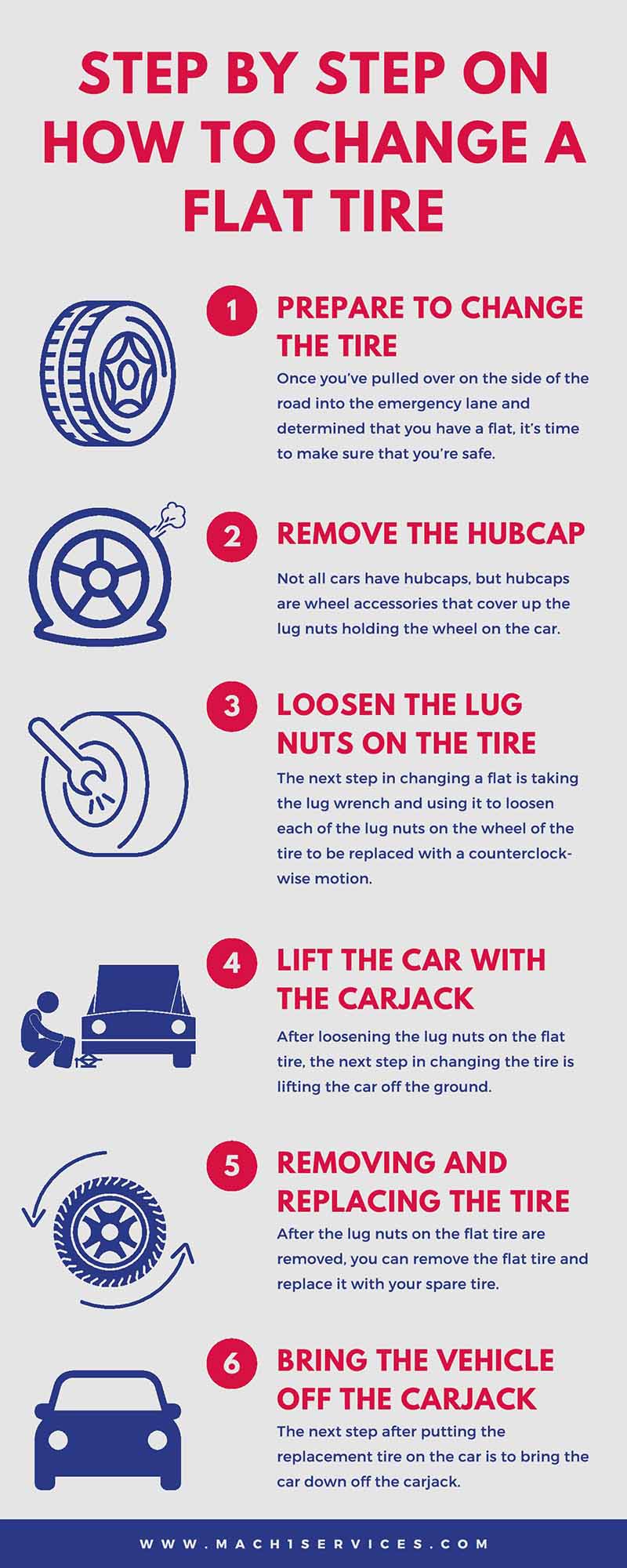HOW TO CHANGE A FLAT TIRE IN FIVE STEPS

- Step One: Get Safe. Before you exit your vehicle, you need to pull over or find a place away from the rush of traffic on the road. …
- Step Two: Grab Your Tools. …
- Step Three: Loosen and Lift. …
- Step Four: Change the Tire. …
- Step Five: Lower and Tighten.
Nowadays, many drivers have roadside assistance services that will come fix your flats, but it’s always smart to know how to change a flat yourself. Since it’s a fairly common occurrence, car manufacturers have tried to make the tire change process one that virtually anyone can do.
Tools You Need to Change a Tire
Keep the following tire-changing essentials in your vehicle at all times:
- Spare tire.
- Usually located under the floor mat in the trunk. SUVs or trucks may have the spare mounted underneath or on the back of the vehicle.
- TIP: Check your spare regularly to ensure it’s properly inflated.
- Jack.
- Lug wrench.
- Flashlight with working batteries.
- Flares and reflective triangles.
- Gloves.
- Leather is ideal since it works well in a variety of weather conditions.
- Wheel wedges.
- Flat tire repair kit.
- Optional, but ideal if you can’t get your tire to a shop right away.
The spare tire, jack, and lug wrench are vital and should all come with your vehicle. If any of these three are missing, replace them immediately. Always keep your vehicle owner’s manual in your car, as it will include details on where you can find your spare and steps for changing your tire.
Find a Safe Spot
In the event that your tire blew out while you were on the road, slow down, put your hazard lights on, and find a safe place to change your tire. If you are driving on a freeway or busy city street, it’s best to get as far away from traffic as possible.
Ideal locations for changing a tire include:
- A quiet side street.
- The shoulder of an off ramp.
- A parking lot.
- A long, straight road.
If you can, try to pull over on a flat road, not an incline. Also, changing a tire on a paved road is ideal. If you cannot safely maneuver your car to one of these areas, pull over as far to the right as you can to put space between your car and traffic.
Steps to Changing a Flat Tire
Once your car is in a safe and stable area, parked with the parking brake engaged, follow these steps to change your flat tire.
- Remove your spare and the tools you’ll need.
- Place flares or reflective triangles behind your vehicle for safety, if you’re changing your tire on the road.
- Place wheel wedges against the tires opposite of the flat. This will help keep your vehicle secure while it’s on the jack.
- Remove the hubcap or wheel cover. If your lug nuts are exposed, skip this step. Use the flat end of the lug wrench to pry the cover off.
- Loosen (but DON’T REMOVE) the lug nuts using the lug wrench.
- Move the jack underneath the car. Reference your vehicle owner’s manual for the proper location and how to work your jack. Ideally, it will be as easy as turning a crank. Raise it up to connect with your car’s frame.
- Expand the jack until the flat is approximately 6 inches off the ground. Warning: Do not put any part of your body under the vehicle!
- Unscrew and remove lug nuts. Place these somewhere safe—you’ll need them all to secure the spare.
- Remove the flat tire from the hub. Grab the flat securely with both hands and pull toward you. Set it aside safely.
- Align the spare with the exposed lug bolts. Push it in place.
- Replace the lug nuts and tighten by hand. Do NOT use the wrench until you lower the vehicle.
- Lower the jack carefully until the spare touches the ground. Remove the jack.
- Tighten the lug nuts with the wrench. Put your weight into it—these should be really tight. To ensure even alignment, tighten your lug nuts in a star pattern, so you’re never tightening lug nuts that are immediately adjacent to one another.
- Replace the hubcap or wheel cover, if you have one.
- Check the pressure on your spare. If you don’t have a tire gauge, try to drive to a gas station to check and make sure it’s safe.
Once your spare is safely and securely on your car, take your flat tire to a repair shop. Driving long distances at high speeds on a spare is not advisable, so try to get your flat tire replaced or repaired as soon as possible.
When to Call for Backup
Changing your own tire can be a cost effective option if you don’t have emergency roadside assistance coverage. But safety should always be your top priority. Keep the following in mind when deciding whether to DIY or call for help.
Road & Traffic Conditions
Consider whether you can pull your car over in a safe location, away from oncoming traffic and onto a smooth, flat surface. If you’re on a busy freeway, a narrow shoulder, a dirt road, an incline, or a slick surface, think carefully before pulling out the jack.
Weather Conditions
If it’s dumping rain or snow, if the wind is howling and you might lose your grip on any of your equipment, or if the blazing heat could put your health or safety at risk, consider calling for a tow.
Passenger Safety
If you’re traveling with your family, friends, or even pets, take stock of your environment and their safety. If the conditions are not ideal, don’t take unnecessary risks just to save a few bucks.
Equipment Condition
In order to be properly prepared, make sure your spare is inflated and in good condition. If you’re missing any other equipment, if your jack is rusty, even if your flashlight batteries are dead, don’t try to be a hero—call a tow truck and get the help you need.

